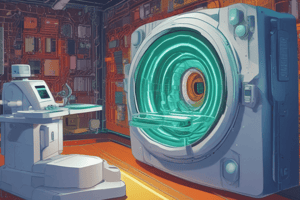Podcast
Questions and Answers
What is the primary purpose of a slip ring in CT scanners?
What is the primary purpose of a slip ring in CT scanners?
- To enhance image resolution
- To eliminate inter-scan delays (correct)
- To improve the cooling system of the X-ray tube
- To reduce X-ray exposure time
How do slip rings transmit electrical energy across a moving interface?
How do slip rings transmit electrical energy across a moving interface?
- By using fixed cable connections
- By employing wireless signal boosters
- Through mechanical gears
- With circular conductive rings and brushes (correct)
What significant engineering advancement does the slip ring technique allow for in CT scanning?
What significant engineering advancement does the slip ring technique allow for in CT scanning?
- Uninterrupted patient monitoring during scans
- Enhanced chemical processing of images
- Continuous rotation of the scan frame (correct)
- Automated table movement without delay
What challenge arose from reducing inter-scan delays in CT scanners using slip rings?
What challenge arose from reducing inter-scan delays in CT scanners using slip rings?
What actions are reduced to 50% of the time spent during a combined scan process using slip rings?
What actions are reduced to 50% of the time spent during a combined scan process using slip rings?
Flashcards
Slip Ring
Slip Ring
A rotating mechanical device that allows continuous data transmission in CT scanners by eliminating the need for winding and unwinding cables.
Inter-scan delay
Inter-scan delay
The time delay between consecutive CT scans due to the need to wind and unwind cables for data transmission.
Continuous Rotation
Continuous Rotation
The ability of a CT scanner to acquire data continuously without stopping for cable rewinding, thanks to the use of a slip ring.
Slip Ring CT Scanner
Slip Ring CT Scanner
Signup and view all the flashcards
Thermal Demands
Thermal Demands
Signup and view all the flashcards
Study Notes
Slip Rings in CT Scanners
- Older CT scanner generations (excluding 4th gen) had inter-scan delays due to cable winding/unwinding.
- Slip rings were developed to eliminate these delays.
- A slip ring is a drum with grooves for electrical contact brushes.
- Data transmission from detectors uses high-capacity wireless technologies, enabling continuous rotation.
- Slip ring technology completely eliminates inter-scan delays, except for table movement time.
- Example: If scan and table movement each take 1 second, data acquisition time is 50% of total time.
Function of Slip Rings
- Slip rings are electromechanical devices.
- They consist of conductive rings and brushes.
- They transmit electrical energy without fixed connections.
- They carry power and control signals from stationary scanner components to the rotating parts.
- Slip ring design uses concentric conductive rings connecting to the X-ray tube, detectors, and control circuits through sliding contactors.
- This continuous rotation eliminates the need to stop for cable rewinding.
Impact of Slip Rings
- Initially, the goal was to reduce inter-scan delay and improve data throughput.
- The reduced delay increased thermal demands on the X-ray tube.
- This necessitated X-ray tubes with higher thermal capacities to handle continuous operation during multiple rotations.
Studying That Suits You
Use AI to generate personalized quizzes and flashcards to suit your learning preferences.




